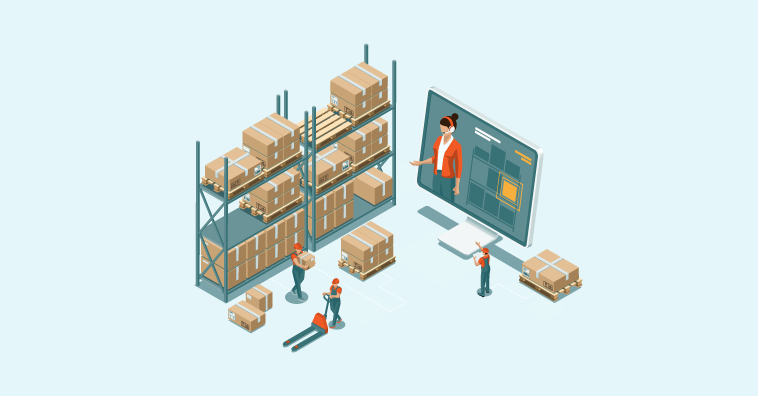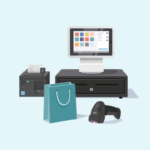For retailers, inventory management is business-critical. When it’s done well, shelves are fully stocked, customers find what they’re looking for, and sales growth goals are achieved. However, inventory management was simpler in a single channel, brick-and-mortar retail world. Today, with e-commerce, mobile, and social media sales channels added to the mix, effective inventory management is more complex, automated, and integrated. Smart retailers are practicing omnichannel inventory management to keep their finger on the pulse of what’s in stock, what’s selling faster (or slower) than projected, and how supplier turnaround times are trending.
What is omnichannel inventory management?
Omnichannel inventory management is integrated inventory tracking and reporting across all channels where retailers sell their products, including brick and mortar stores, e-commerce websites, and social media platforms. When retailers go omnichannel, inventory management, forecasting, and customer fulfillment processes must also take an omnichannel approach.
Having integrated point-of-sale (POS) capabilities that bring together inventory management across channels isn’t a nice-to-have. In the current fast-evolving and competitive retail environment, retailers must have real-time access to consolidated inventory reports of what’s in stock, what’s sold, and what’s been ordered. In many cases, omnichannel inventory management can be the difference between a sale and a lost customer. Industry experts calculate that retailers lose out on approximately $1 trillion in sales each year simply because the items customers want to buy are out of stock.
Related: Omnichannel Retail: The POS Essentials That Make It Possible
Why inventory management matters more than ever
Omnichannel inventory management is key to delivering the omnichannel shopping experience that today’s customers expect. Omnichannel retail is not just offering customers multiple purchasing channels. Rather, an omnichannel strategy connects the different channels together – in-store, e-commerce, mobile, and social media – to provide customers with a seamless experience as they switch from channel to channel.
Most retailers need to make a transition to provide an omnichannel experience because they started out in a single channel and added additional options over time. When integrating the channels across offline and online customer experiences, retailers should also tackle streamlining their behind-the-scenes inventory management capabilities. Along with helping to enhance a customer’s overall experience, omnichannel inventory management also creates time-saving efficiencies for the retailer.
3 reasons to practice omnichannel inventory management
1. Enhanced customer experiences
Competition for customers is high. With so many shopping options, the customer experience a retailer delivers is an increasingly important differentiator. Availability, convenience, and value are the top three factors driving where a consumer chooses to shop and buy. Omnichannel inventory management addresses all three.
By integrating inventory management within its POS system, a retailer tracks sales across channels in real-time. They’re able to set inventory minimums and maximums for each item and even place automated orders with suppliers. As a result, the retailer doesn’t run low on popular items, and customers are able to find what they’re looking for and make the purchase immediately. Plus, retailers are less likely to overstock items, tying up less capital in inventory, lowering overhead, and keeping prices competitive.
Related: Stockouts Cause Walkouts: 3 Ways to Avoid Out-of-Stock Inventory
2. Increased efficiencies
Busy – and short-staffed – retailers don’t have time to consolidate separate channel-specific inventory data to gain an all-in view. Omnichannel inventory management eliminates the need for separate reports and spreadsheets. In their place, the integrated POS system becomes the centralized source for all inventory data, down to the SKU level. This overarching, up-to-the-minute view is critical for spotting unexpected upticks in customer purchasing patterns and adjusting accordingly. This way, retailers spend their time on building their business and serving customers, not cutting and pasting data before they’re able to check inventory levels and analyze trends.
3. Improved visibility
Retail forecasting is part art and part science. Omnichannel inventory management gives retailers the data they need to forecast customer demand and determine how much inventory to purchase. Even more importantly, access to automated and ad-hoc inventory reports through an integrated POS system helps retailers monitor and adjust, especially during busy shopping seasons. For example, omnichannel inventory management can help retailers factor in supply chain delays. Using historical inventory tracking data, retailers can accurately calculate the appropriate safety stock or cushion inventory quantities they need to maintain for each product.
Related: What Your Inventory Management Says About the Health of Your Retail Business
Ready to take an omnichannel approach to inventory management? POSIM – a point-of-sale and inventory management system – makes it possible to deliver an omnichannel shopping experience to your customers with integrated inventory data and comprehensive reporting. To explore what POSIM can do for your business, contact us for a demo today.












